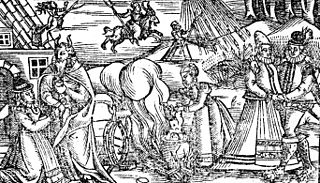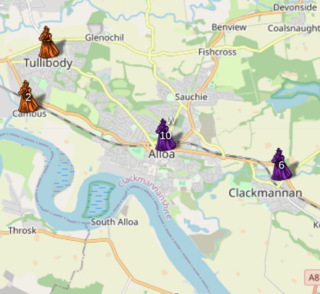Related Research Articles

Isobel Gowdie was a Scottish woman who confessed to witchcraft at Auldearn near Nairn during 1662. Scant information is available about her age or life and, although she was probably executed in line with the usual practice, it is uncertain whether this was the case or if she was allowed to return to the obscurity of her former life as a cottar’s wife. Her detailed testimony, apparently achieved without the use of violent torture, provides one of the most comprehensive insights into European witchcraft folklore at the end of the era of witch-hunts.
Queen of Elphame or "Elf-hame", in the folklore belief of Lowland Scotland and Northern England, designates the elfin queen of Faerie, mentioned in Scottish witch trials. In ballads and contemporary texts, she is referred to as Queen of Elphane, Elphen, or the Fairies. She is equivalent to the Queen of Fairy who rules Faërie or Fairyland. The character as described in witch trials has many parallels with the legends of Thomas the Rhymer and Tam Lin.

In early modern Scotland, in between the early 16th century and the mid-18th century, judicial proceedings concerned with the crimes of witchcraft took place as part of a series of witch trials in Early Modern Europe. In the late middle age there were a handful of prosecutions for harm done through witchcraft, but the passing of the Witchcraft Act 1563 made witchcraft, or consulting with witches, capital crimes. The first major issue of trials under the new act were the North Berwick witch trials, beginning in 1590, in which King James VI played a major part as "victim" and investigator. He became interested in witchcraft and published a defence of witch-hunting in the Daemonologie in 1597, but he appears to have become increasingly sceptical and eventually took steps to limit prosecutions.

Witchcraft in Orkney possibly has its roots in the settlement of Norsemen on the archipelago from the eighth century onwards. Until the early modern period magical powers were accepted as part of the general lifestyle, but witch-hunts began on the mainland of Scotland in about 1550, and the Scottish Witchcraft Act of 1563 made witchcraft or consultation with witches a crime punishable by death. One of the first Orcadians tried and executed for witchcraft was Allison Balfour, in 1594. Balfour, her elderly husband and two young children, were subjected to severe torture for two days to elicit a confession from her.

Elspeth Reoch was an alleged Scottish witch. She was born in Caithness but as a child spent time with relatives on an island in Lochaber prior to travelling to the mainland of Orkney.

The Pittenweem witches were five Scottish women accused of witchcraft in the small fishing village of Pittenweem in Fife on the east coast of Scotland in 1704. Another two women and a man were named as accomplices. Accusations made by a teenage boy, Patrick Morton, against a local woman, Beatrix Layng, led to the death in prison of Thomas Brown, and, in January 1705, the murder of Janet Cornfoot by a lynch mob in the village.

Margaret Aitken, known as the Great Witch of Balwearie, was an important figure in the great Scottish witchcraft panic of 1597 as her actions effectively led to an end of that series of witch trials. After being accused of witchcraft Aitken confessed but then identified hundreds of women as other witches to save her own life. She was exposed as a fraud a few months later and was burnt at the stake.

The Bute witches were six Scottish women accused of witchcraft and interrogated in the parish of Rothesay on Bute during the Great Scottish Witch Hunt of 1661–62. The Privy Council granted a Commission of Justiciary for a local trial to be held and four of the women – believed by historians to be Margaret McLevin, Margaret McWilliam, Janet Morrison and Isobell McNicoll – were executed in 1662; a fifth may have died while incarcerated. One woman, Jonet NcNicoll, escaped from prison before she could be executed but when she returned to the island in 1673 the sentence was implemented.
Beatrix Leslie was a Scottish midwife executed for witchcraft. In 1661 she was accused of causing the collapse of a coal pit through witchcraft. Little is known about her life before that, although there are reported disputes with neighbours that allude to a quarrelsome attitude.
Margaret Burges, also known as 'Lady Dalyell', was a Scottish businesswoman from Nether Cramond who was found guilty of witchcraft and executed in Edinburgh in 1629.
Issobell Young was a wife of a tenant farmer residing in the village of East Barns in the parish of Dunbar, Lothian, Scotland. She was tried, strangled, and burned at the stake at Castle Hill, Edinburgh for practising witchcraft.

The Survey of Scottish Witchcraft is an online database of witch trials in early modern Scotland, containing details of 3,837 accused gathered from contemporary court documents covering the period from 1563 until the repeal of the Scottish Witchcraft Act in 1736. The survey was made available online in 2003 after two years of work at the University of Edinburgh by Julian Goodare, now a professor of history at the University of Edinburgh, and Louise Yeoman, ex-curator at the National Library of Scotland, now a producer/presenter at BBC Radio Scotland, with assistance from researchers Lauren Martin and Joyce Miller, and Computing Services at the University of Edinburgh. The database is available for download from the website.
Julian Goodare is a professor of history at University of Edinburgh.
Jean Lyon, Countess of Angus was a Scottish courtier and landowner, who became involved in a witchcraft trial.
Louise Yeoman is a historian and broadcaster specialising in the Scottish witch hunts and 17th century Scottish religious beliefs.
The Witches of Bo'ness were a group of women accused of witchcraft in Bo'ness, Scotland in the late 17th century and ultimately executed for this crime. Among the more famous cases noted by historians, in 1679, Margaret Pringle, Bessie Vickar, Annaple Thomsone, and two women both called Margaret Hamilton were all accused of being witches, alongside "warlock" William Craw. The case of these six was "one of the last multiple trials to take place for witchcraft" in Scotland.
Violet Mar was a Scottish woman accused of plotting the death of Regent Morton by witchcraft.

Margaret Duchill was a Scottish woman who confessed to witchcraft at Alloa during the year 1658. She was implicated by others and she named other women. She was executed on 1 June 1658.
Anna Tait or Anne Tait, also known as 'Hononni', was accused of witchcraft in Haddington, East Lothian in 1634 and executed in 1635. Her case revolved around her feelings of grief and guilt which caused her suicidal thoughts for the murder of her first husband and the death of her beloved daughter following a botched home abortion.
Isobel Elliot, sometimes called Isobell Eliot, was a woman accused of witchcraft from Peaston, near Ormiston in East Lothian. She was tried as a witch in Edinburgh during 1678, and executed on 20 September 1678 at Peaston by being strangled and burnt at the stake.
References
- 1 2 3 4 5 6 7 8 The new biographical dictionary of Scottish women. Ewan, Elizabeth. Edinburgh. 15 October 2018. ISBN 9781474436298. OCLC 1057237368.
{{cite book}}: CS1 maint: location missing publisher (link) CS1 maint: others (link) - 1 2 The Scottish witch-hunt in context. Goodare, Julian. Manchester, UK: Manchester University Press. 2002. p. 46. ISBN 0719060230. OCLC 49551469.
{{cite book}}: CS1 maint: others (link) - 1 2 3 4 Bullen, Arthur Henry, "Adamson Patrick", Dictionary of National Biography, 1885-1900, vol. 01, retrieved 6 September 2019
- ↑ David Hay Fleming, Register of St Andrews Kirk Session, vol. 2 (Edinburgh, 1890), pp. 508-9.
- ↑ Miller, Joyce (2008), "Men in Black: Appearances of the Devil in Early Modern Scottish Witchcraft Discourse", Witchcraft and Belief in Early Modern Scotland, Palgrave Macmillan UK, pp. 144–165, doi:10.1057/9780230591400_7, ISBN 9781349353767
- ↑ Martin, Lauren; Miller, Joyce (2008), "Some Findings from the Survey of Scottish Witchcraft", Witchcraft and Belief in Early Modern Scotland, Palgrave Macmillan UK, pp. 51–70, doi:10.1057/9780230591400_3, ISBN 9781349353767
- ↑ Goodare, Julian (2008), "Scottish Witchcraft in its European Context", Witchcraft and Belief in Early Modern Scotland, Palgrave Macmillan UK, pp. 26–50, doi:10.1057/9780230591400_2, ISBN 9781349353767
- ↑ Yeoman, Louise (2009). "Away with the fairies". In Henderson, Lizanne (ed.). Fantastical imaginations: the supernatural in Scottish history and culture. J. Donald. ISBN 9781906566029.